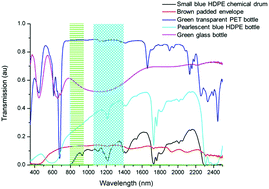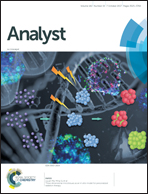Correcting transmission losses in short-wave infrared spatially offset Raman spectroscopy measurements to enable reduced fluorescence through-barrier detection†
Abstract
Spatially offset Raman spectroscopy (SORS) is a proven technique for sub-surface detection. SORS is able to separate Raman signals from a container and its contents, thereby demonstrating application to through-barrier detection for defence and security. Whilst SORS has been demonstrated to reduce fluorescence from the barrier (or surface), fluorescence from the sample (or sub-surface) can still be problematic for some materials when using Raman excitation wavelengths typical in commercially available instrumentation (e.g. 785 nm). Previous work has demonstrated that short-wave infrared (SWIR) excited SORS (e.g. 1064 nm) can reduce fluorescence from the sample and barrier, thereby providing the potential to detect a wider range of materials through a wider range of barriers. In this paper we highlight an additional challenge for detection through some plastic container materials (e.g. high density polyethylene (HDPE) and other opaque plastics) that absorb and scatter both incident and Raman scattered photons in the SWIR band, leading to distortion of the resultant SORS spectrum. The existence of this effect and its impact is explored, along with a potential solution to overcome this challenge that uses multi-wavelength Raman excitation to avoid the detrimental HDPE absorption region.



 Please wait while we load your content...
Please wait while we load your content...